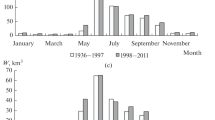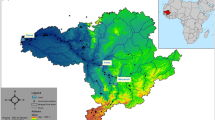Abstract
Studies of water balance and variations of water regime of rivers in the Don Basin have shown a steady trend toward a decrease in spring flood volumes and an increase in runoff volume in winter since the mid-1980s. More frequent thaws have resulted in that snowmelt runoff formation can be seen almost throughout winter. A decrease in soil moisture content in the late October along with a decrease in the maximal freezing depth in the major portion of the basin increases water losses during thaws and at the early stages of spring flood. At a considerable decrease in the water equivalent of snow cover along with an appreciable increase in water losses, spring flood will not occur in some years. Therefore, changes in the climate and anthropogenic load considerably reduce the reliability of relationships developed in the XX century and used to forecast the spring inflow into the Tsymlyansk Reservoir.











Similar content being viewed by others
REFERENCES
Apollov, B.A., Kalinin, G.P., and Komarov, V.D., Kurs gidrologicheskikh prognozov. Ucheb (Course on Hydrological Forecasts. Textbook), Leningrad: Gidrometeoizdat, 1974.
Vershinina, L.K., Method for calculating and forecasting the spring flood runoff volume in the Don Basin, Tr. Gos. Gidrogeol. Inst., 1977, no. 223, pp. 52–65.
Vershinina, L.K. and Krestovskii, O.I., Incorporating the water-absorption capacity of catchments in forecasting spring flood runoff, Tr. Gos. Gidrogeol. Inst., 1980, no. 265, pp. 3–30.
Georgievskii, Yu.M. and Shanochkin, S.V., Gidrologicheskie prognozy (Hydrogeological Forecasts), St. Petersburg: Ross. Gos. Gidromet. Univ., 2007.
Dzhamalov, R.G., Kireeva, M.B., Kosolapov, A.E., and Frolova, N.L., Vodnye resursy basseina Dona i ikh ekologicheskoe sostoyanie (Water Resources of the Don and Their Ecological Conditions), Moscow: GEOS, 2017.
Kireeva, M.B. and Frolova, N.L., Present-day features of the spring flood in the Don basin, Vod. Khoz. Rossii: Probl., Tekhnol., Upravl., 2013, no. 1, pp. 60–76.
Komarov, V.D., Dolgosrochnyi prognoz vesennego stoka rek chernozemnoi zony Evropeiskoi chasti SSSR na osnove territorial’no obshchikh zavisimostei (Long-Term Forecast of Spring Runoff in Rivers of the Black-Earth Zone, European Part of the USSR Based on Territorially Common Relationships), Leningrad: Gidrometeoizdat, 1955.
Parshin, V.N. and Salov, M.S., Vesennii stok v basseine r. Dona i ego predvychislenie (Spring Runoff in the Don Basin and Its Forecasting), Leningrad: Gidrometeoizdat, 1955.
Spetsializirovannye massivy dlya klimaticheskikh issledovanii FGBU VNIIGMI-MWD (Specialized massifs for climate studies of Fed. State Budg. Inst. RIHMI-WDC). http:// www.aisori-m.meteo.ru (Accessed: September 10, 2019).
Churiulin, E.V., Kopeikin, V.V., Rozinkina, I.A., Frolova, N.L., and Churyulina, A.G., Analysis of snow cover characteristics by satellite and model data for various catchments in European Russia, Tr. Gidrometts. Ross., 2018, vol. 368, no. 2, pp. 120–143.
Brecht, Martens., Diego, G., Miralles, Hans., Lievens, Robin., van der Schalie, Richard, A.M., de Jeu, Diego., Fernandez-Prieto, Hylke, E., Beck, Wouter A. Dorigo, Niko E. Verhoest, GLEAM v3: satellite-based land evaporation and root-zone soil moisture, Geosci. Model Dev., 2017, vol. 10, pp. 1903–1925.
Churiulin, E.V., Krylenko, I.N., Frolova, N.L., and Belyaev, B.M., Research of opportunities of combined use of the runoff formation ECOMAG model and mesoscale atmosphere circulation COSMO-Ru model (on the example of floods on the Sukhona River at the Velikiy Ustyug), IOP Conf. Sers, Bristol: UK.: Earth and Environ. Sci. Inst. Physics Publ., 2019, vol. 263, pp. 1–7.
European Space Agency CCI—Soil Moisture Product. http://www.esa-soilmoisture-cci.org (Accessed: September 21, 2019).
Gafurov, A., Lűdtke, S., Unger-Shayesteh, K., Vorogushyn, S., Schone, T., Schmidt, S., Kalashnikova, O., and Merz, B., MODSNOW-Tool: an operational tool for daily snow cover monitoring using MODIS data, Environ. Earth Sci. 1078. vol. 75.
Global Land Evaporation Amsterdam Model—GLEAM. http://www.gleam.eu (Accessed: September 19, 2019).
GrWat tool for hydrograph separation and analysis. http:// https://tsamsonov.github.io/grwat/index.html (Accessed: October 11, 2019).
Kireeva, M., Frolova, N., Rets, E., Samsonov, T., Entin, A., Kharlamov, M., and Telegina, E., Evaluating climate and water regime transformation in the European part of Russia using observation and reanalysis data for the 1945–2015 period, Int. J. River Basin Management, 2019.11.25. 2019. https://doi.org/10.1080/15715124.2019.1695258
SMAP or Soil Moisture Active Passive. http:// www.nasa.gov (Accessed: September 30, 2019).
SMOS—Soil Moisture and Ocean Salinity. http:// www.directory.eoportal.org (Accessed: September 24, 2019).
VanderSat project. www.vandersat.com/ (Accessed: November 11, 2019).
Funding
This study was carried out under Governmental Contract (no. 78/2-NIR/FTsP-2018 for the implementation of researches between Moscow State University and FRC Agroekologii, Russian Academy of Sciences, under Federal Target-Oriented Program “Development of Water-Management Complex of the Russian Federation in 2012–2020” on the subject “Long-Term Forecast of Variations of Water Resources with the Aim to Ensure Sustainable Functioning of Water Management Complex in the Don River Basin”). The development of the methodological approaches and algorithms used in this study is supported by the Russian Science Foundation, project no. 19-77-10 032.
Author information
Authors and Affiliations
Corresponding author
Additional information
Translated by G. Krichevets
Rights and permissions
About this article
Cite this article
Varentsova, N.A., Kireeva, M.B., Frolova, N.L. et al. Forecasting Water Inflow into the Tsimlyansk Reservoir during Spring Flood under Current Climate Conditions: Problems and Reproducibility. Water Resour 47, 953–967 (2020). https://doi.org/10.1134/S0097807820060159
Received:
Revised:
Accepted:
Published:
Issue Date:
DOI: https://doi.org/10.1134/S0097807820060159




